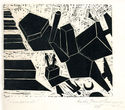
19th, 20th & 21st Century Fine Prints
707-546-7352 · fax 707-546-7924 · web: www.annexgalleries.com · email: artannex@aol.com
Hector Bianchi Dominguez Biography
Hector Bianchi Dominguez
Argentine
1928–1997
Biography
Héctor Bianchi Domínguez was born in San Luis, Argentina in 1928. He graduated from the Art School of the National Institute of Córdoba as a Senior Professor of Painting. He then traveled and exhibited in Chile and Brazil. He then received a scholarship from the Institute of Hispanic Culture which allowed him to travel to Madrid, Spain to study painting and Art History. He then traveled to Paris with artist friend Raul Pecker to present an exhibition of plastic artists at the Casa Argentina de Paris.
He studied further with Ercilio Dominguez in San Luis and Lino E. Spilimbergo in Cordoba and later became the first director of the School of Plastic Arts. As a teacher he worked at the national university of the Mediterranean province and there he also directed the Superior School of Fine Arts Dr. José Figueroa Alcorta and taught art history and morphology. After a long and distinguished career Bianchi retired from the school. In 1985 he moved to Patagonia with his family, with the aim of being the architect of a new construction: the Plastic School of INSA (Higher National Institute of Art, today IUPA). That decision led to again his leaving his career as an artist for a renewed commitment to teaching. His career at INSA lasted 10 years during which he served as director. After retiring from the activity he continued to live in Roca, Argentina. Then he moved to Córdoba where he died in 1997.
His colleagues noted: “He was the builder of an educational project that still maintains its mysticism. Teacher of artists. Adventurer who accepts the challenge of abandoning the security of the known. Skillful and intelligent but simple, austere and supportive. Those who knew Hector Bianchi Dominguez remember him as a teacher who got into the hearts of his students. A passionate man, firm and categorical, who did not avoid discussion and debate. A teacher in the art of knowing how to orient without the other perceiving that he is being oriented.”

